Fire River boats PG
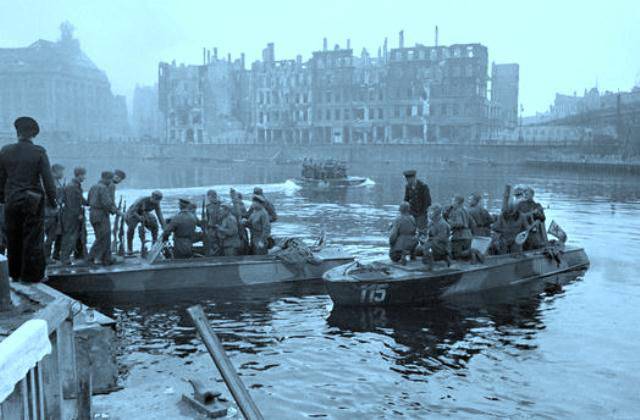
In May 1945, shortly after the end of World War II, Marshal G.K. Zhukov parsed the Berlin operation. When the floor was given to the commander of the 9th Red Banner Brandenburg Rifle Corps, Lieutenant General I.P. To Rosloma, he stood up and, addressing the chairman, said: “Allow me, Comrade Marshal, before starting my speech, to thank our glorious sailors, without whose heroic help the corps entrusted to me could not have completed the task.” With these words, the general turned towards the commanders of the Dnieper military flotilla and bowed to them with a Russian bow. Three dozen sailors, led by Lieutenant M.M., deserved this appreciation. Kalinin, who fought on the smallest ships of the Soviet fleet - half-gliders.
Wooden, open to all the winds of the boat, in appearance and size little different from the current river motorboats - such were the half-wars of wartime, once produced as peaceful service and traveling boats "NCL-27". Since the beginning of the war, they were mobilized and introduced into the Volga military flotilla. Later, as the fighting moved westward, the Dnieper Flotilla was formed at its base.
At first they were used only as high-speed traveling boats, and later turned into universal warships, indispensable in river conditions. It was necessary to equip the hydroplanes with a Maxim machine gun, which was mounted on a special tripod in the mid-section area. After this, the “PG” boats began to be used more and more often both for support of combat operations of the formations of other ships, and directly for carrying out a number of independent combat missions. At first, these were reconnaissance of the coast and depth measurements, the landing of sabotage and reconnaissance groups, the removal of wounded from ships damaged during the battle. In the future, the range of tasks solved by hydroplane expanded. They were indispensable participants in the landing of landings. They had to transfer entire military units, tow pontoons with heavy equipment, and work with sappers, who called for crossings.
Having absolutely no protection from bullets and shrapnel, but having high speed, low draft (about 20 cm at full speed) and great maneuverability, the PG boats suddenly appeared under the very nose of the enemy, did their job and just as quickly left Getting off, as a rule, only with holes in the surface part. And the damage to the board hull was quickly sealed by the crew. After all, this did not require any machine tools or welding. Enough was the simplest tool. As the combat experience showed, it was far from easy to sink the hydroplane. Cases of their death were very rare. Thus, in the 1 brigade of the Dnieper flotilla, there were only two such cases registered over time: one boat died on the Oder, the other on the Spree, already in Berlin.
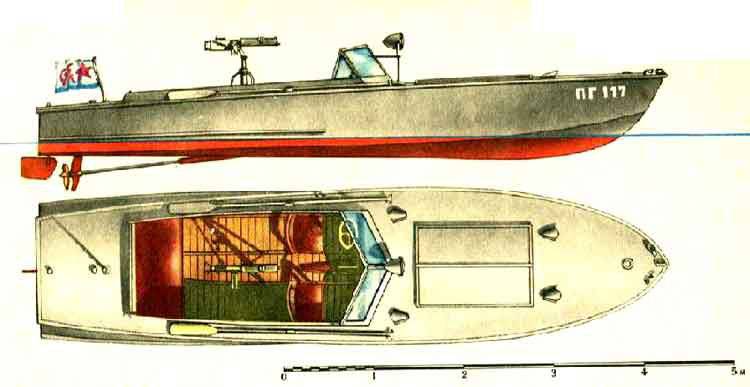
From the crew of "PG", consisting of two people - the commander and mechanic-machine gunner, required extraordinary courage and determination, the ability to instantly assess any situation. They were, in addition to everything, well-versed in the navigational environment: it was the small-seating semi-wagons who had to pave the way for the rest of the heavy ships of the flotilla when moving along unfamiliar sections of rivers and canals. This is in the absence of any navigational signs, and even charts, when the fairways, as a rule, were mined and cluttered, and the moorings were blown up.
The crew was required and complete interchangeability. This last requirement dictated the combat experience. It often happened that the wounded or killed boat commander had to be replaced by an engineman. Sometimes and vice versa. But in all cases the hydroplane continued to perform the task. It should be noted that the designers made this boat extremely simple in design and management. The engine from the passenger car ("emki") was reliable and unpretentious. Everything is at hand. Maneuverability is exceptional.
From one theater of war to another, boats were easily transferred by rail, or even by truck, which turned out to be an invaluable advantage of the “PG” in combat conditions. Loading and unloading was done manually - with winches on sloping snow.
Here are some examples of combat use of hydroplanes from stories Red Banner Order of Ushakov I degree of the Dnieper Flotilla, which included a separate detachment of hydroplanes in the number of 12 units, under the command of Lieutenant MM. Kalinin.
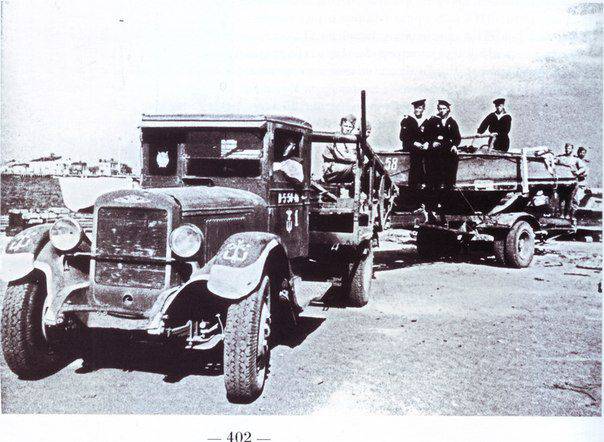
In 1944, the flotilla supported the offensive of the troops of the 1 of the Byelorussian Front on Bobruisk. Entering the Berezina River, Soviet floating batteries and armored boats fired at the enemy’s combat positions and crossings, landed landings to the enemy’s rear, and sent their troops through water obstacles. Virtually all of these actions involved the "PG" of Kalinin's detachment.
On the night of June 26, an armored trooper with paratroopers went up the Berezina. Ahead went "PG-103" under the command of the foreman 1 article A. E. Lebedev. Under the cruel fire of the enemy, from the boat, in cold blood and methodically, they measured the depths on the approach to the right bank - right next to the village, which made it possible to land. By dawn, the paratroopers were behind the main line of defense and hit the rear of the enemy. The same hydrofoil in the most difficult moments of the battle provided communication with the paratroopers, took out the wounded. During one of the flights to the right bank by an explosion of mines by A.E. Lebedeva contused, the boat received a dozen holes, but safely reached its own. For courage and bravery the foreman was awarded the Order of the Red Banner.
With an exceptionally daring assault landing in Pinek at night 12 on July 1944, the crews of “PG” No. 77, 103, 107 and 109 especially distinguished themselves. A whole rifle regiment was landed on the city's embankment, which was behind enemy lines 22 km behind the front line. It is worth saying that the whole detachment over and above any measure of overloaded armored boats was to pass secretly along Pripyat. Walk in complete darkness and at maximum speed, nowhere stranded. And here, in front of the column of armored cars, the semi-wagon "PG-77" of the foremen of 1 by G. Alaverdyan followed. From this boat they conducted reconnaissance of the coast, from which they managed to measure the depths and show the safe way to the armored boats. The detachment safely reached the city and landed troops without a single shot.
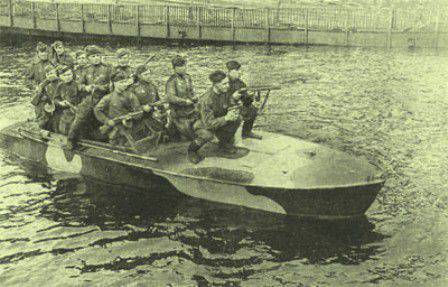
The fascists were clearly not expecting such a turn of events. The suddenness of the strike helped the paratroopers to quickly seize the park and the station and begin to advance into the city, which was considered by the enemy to be rear. The German command was forced to withdraw at least two butts from the front line. The city began heavy fighting, which lasted continuously for two days. And all this time, our armored boats, minesweepers and hydroplanes brought up reinforcements, again and again breaking through to Pinsk under fierce fire. At the very berths of the city, armor number 92 was killed, and then in 200 m from it - armored number 2 and minesweeper No. 205. The surviving sailors were rescued by hydroplanes G. Alaverdyan and D. Fastovts.
14 July Pinsk was taken. All the crews of the hydrolisters involved in the operation were awarded orders and medals. The memory of those hard days of the great battle was an armored car raised on a stone pedestal. On the embankment, which was named after the name of the Red Banner Dnieper Flotilla, a memorial plaque was installed at the landing site.
In August-September, the ships of both teams of the flotilla were loaded onto platforms and transferred to the territory of Poland - to the Western Bug. In 16 hours 20 October 1944, six hydroplanes M. Kalinin and several patrol boats, descending along the Western Bug to its confluence with Narew, landed troops in Serock, located about 50 km from Warsaw. Because of the shallow water, heavy ships could not take part in the landing and supported the paratroopers with artillery fire from long positions. Speed and maneuver were the main weapons detachment of light boats. Under the strongest fire of the fascists, the first, at their fullest speed, broke through to the urban berths PG-104 (commander G. Dudnikov, mechanic A. Samofalov), PG-106 (G. Bunin and V. Dudnik) and PG-11 115 ”[commander - G. Kazakov). On each of them were on 10-15 machine gunners. Then the hydroplanes had to play the role of armored boats, supporting the paratroopers with their machine guns.
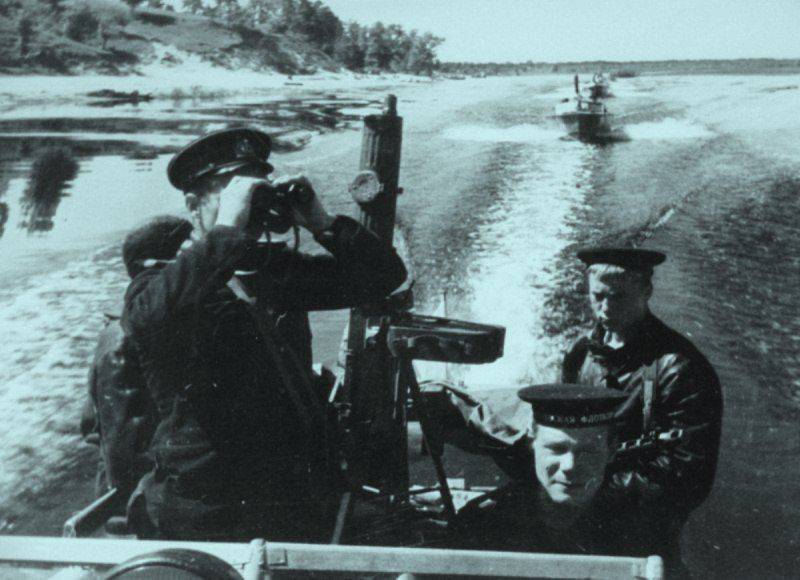
PG-104 has managed to suppress several firing points. The hull of this boat after the battle counted 18 significant holes; but the damaged one remained afloat, and Alexander Samofalov continued firing. Three hours later, our naval flag was hoisted above one of the buildings in the city center.
It was precisely the semi-wishers of the detachment Lieutenant M. Kalinin who were destined to carry this flag to the very center of Berlin. The main forces of the Dnieper flotilla, moving along the Hohenzollern Canal and the Spree River, were able to make their way only to its distant outskirts: the way they were blocked by blown-up bridges flooded across the fairway of the court. Then it was decided to transfer a separate detachment of hydroplanes directly to the advancing units of the 5 th shock army.
At the beginning of the twentieth of April, the 9 th rifle corps of this army, occupying the suburb of Karjhorst, went to Spree in the area of the Penterwald park located on the opposite bank. The corps had a combat mission to attack the Reichstag - no more than 8 km remained to it. But at first it was necessary to force a river with a high edge with high banks lined with stone. The spree is not wide here - no more than 300 meters, but there is not a single surviving bridge, and the crossing is necessary. Everything around is shot through by multi-layer artillery, mortar, machine-gun and even machine-gun fire - the western coast has been turned into a powerful line of defense.
The commander of the 9 Corps, Lieutenant-General I. Rosly, called Lieutenant Kalinin and ordered at any price to ensure the transfer of the assault detachment through Spree on the night of April 23. “The successful fulfillment of the task by the corps,” he stressed, “now depends on you, sailors!”
After the task was set by the detachment, ten hydrolishers were loaded onto trucks and by the evening of April 22 were transferred from Kustrin to Karlhorst. It was difficult to find a suitable place for launching - a small backwater, but the enemy, despite the darkness, immediately noticed the appearance of trucks. Unloading boats had to under fire. The first drove the "Studebaker" with "PG-111". In a hurry during unloading, the baler was bent. Without thinking, Sergeant M. Sotnikov, with a sledge hammer in his hands, rushed into the icy water and straightened the steering wheel with several blows.
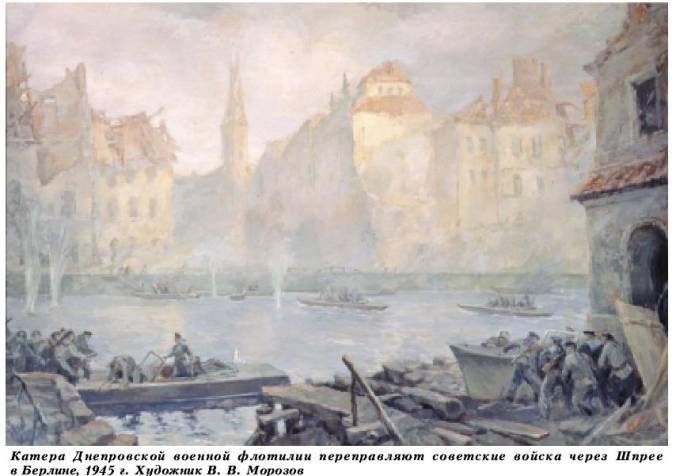
Around 2 at night, the first group of paratroopers appeared on the west bank. Despite the strongest fire, PG-111 and PG-116 managed to deliver about 30 fighters here. For a couple of hours, the detachment hydraulics, having dispersed, managed to make six or seven flights, sending over a hundred fighters, and our fighters entrenched on the enemy coast in three areas that had not yet been connected to one another. Now they had to continuously bring up reinforcements and ammunition. At dawn, the Germans, trying to cut off the paratroopers, concentrated the strongest fire on our crossings. In such a hell of fire Soviet sailors had to make a flight for a flight. In the middle landing area, they approached the coast literally a few meters from the German trenches. Return flights to each boat took six to eight wounded.
It was necessary to transfer equipment. Some of the half-gliders were switched to towing. Tanks transported in twin steel pontoons, 76-mm guns - on rafts from inflatable boats.
Each flight was actually a feat. The commander of the "PG-105" N. Filippov, noticing some confusion paratroopers, he jumped onto the enemy shore and carried the machine gunners. On the way back, his boat came under fire, and the fearless sailor died.
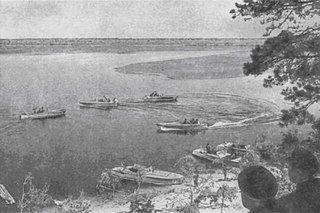
The mortally wounded foreman of 2 article M. Sotnikov did not abandon the steering wheel until he brought his "PG-111" to the chain. He was replaced by a mechanic - N. Baranov, who had just had to repair a broken assault by a splinter. During the eleventh cruise, he was mortally wounded. The boat set on fire by the enemy faustpronom ignited.
When the PG-117 was towing a pontoon with a T-34 tank and a group of fighters, the Nazis managed to set fire to the tank. The explosion of his ammunition threatened with inevitable death of all people on the pontoon. The commander of the boat G. Kazakov, having chopped off the towing end, under heavy fire came up to the pontoon and managed to take down the tank crews and machine gunners some minute before the explosion. It is difficult to believe now, but the small boat PG-117 for one night only under the strongest enemy fire managed to transport more than 400 soldiers to the west bank.
During the fifth voyage, the faustpatron hit the nose of the PG-104. The boat broke out, the foreman G. Dudnikov burned his face and hands, but he continued to lead the boat to the shore. The second explosion Faustprona sailor was killed. To the helm, the motorist A. Samofalov got up. As recorded in the presentation of this crew to the award - conferring the title of Heroes to both of them, during the first four hours of work at the crossing, PG-104 transferred two rifle companies. The boat has covered the enemy mine. Several times it had to extinguish fires and repair damage, but he remained in the ranks. A. Samofalov was struck by a mine shard.
Wounded in his left hand, the commander of the "PG-116" A. Pashkov gave way to the helm of the motorist B. Bochkarev, and he got up to the machine gun. On the way back, the Germans hit the boat with faustpatronami. Bochkarev received a severe wound, Pashkov cut out his right arm. Then, as indicated in the archival document, "Commander Pashkov with his chest leaned on the steering wheel, took the wheel ring with his teeth and drove the boat to its shore, at the time of disembarkation he was killed."
The motorist of the PG-107 V. Cherinov, who replaced the wounded commander and personally transferred paratroopers over the Spree over the 500, also died. He died in flames, his boat.
Of the personnel of ten crews, seven sailors died, three were seriously injured. Not once did Lieutenant M. Kalinin, who led the crossing, himself had to get behind the wheel of a particular boat, temporarily replacing his commander. Repeatedly crossed the Spree and the commissar of the brigade of river ships G. Suvorov.
By the morning of April 24, three groups of our units on the west bank joined and occupied Plenerwald. By the end of the day, the whole Treptow Park was occupied - the one where the monument to the Soviet soldier now stands. The 9 Corps fighters had already moved onto the Reichstag, and a pontoon bridge began to be erected across the Spree using the same PG boats.
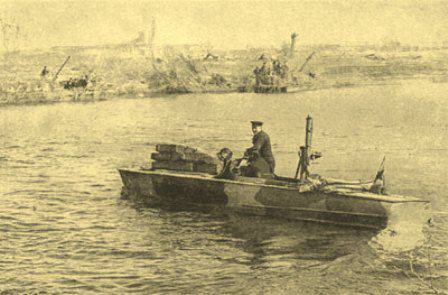
All in all, on semi-gliders and pontoons towed by them for three days under extremely difficult conditions, more than 16000 soldiers, 100 guns and mortars, 27 tanks and self-propelled guns, 700 ammunition wagons were transferred through the Spree. In addition, the detachment boats participated in the reconnaissance of the Spree River within the city, maintained contact between our units located on both banks.
The sailors who fought on the “PG” boats inscribed one of the glorious pages in the annals of the victories of our Navy. For their heroism, one and all, they were awarded orders. Nine of them (seven - posthumously) By the Decree of the Presidium of the Supreme Soviet of the USSR of 31 in May 1945 was awarded the title Hero of the Soviet Union.
Sources:
G. Smirnov, V. Smirnov. Called to the system // Model-designer. 1987. No.4. C.23-25.
Plokhov I., Khvatov S. Sailors of the Dnieper in the battles for Berlin // Sea collection. 1973. No. 5. C. 62-68.
Plekhov I. Boats on the Spree // Boats and Yachts. 1980. No.4. C. 44-48.
Lateral F. The feat of the sailors on the Spree // Military-Historical Journal. 1971. No. 1. C.37-41.
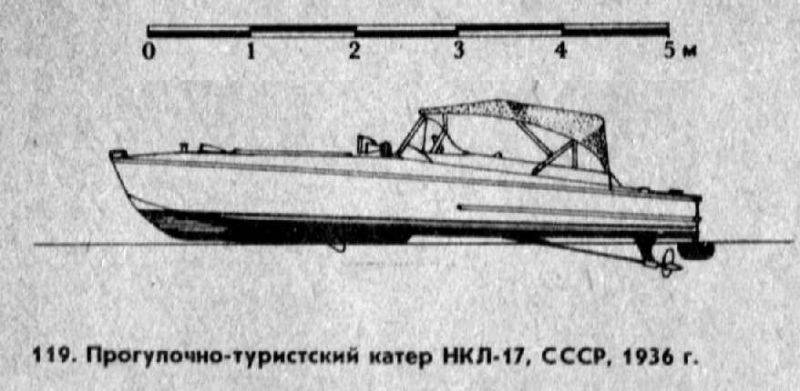
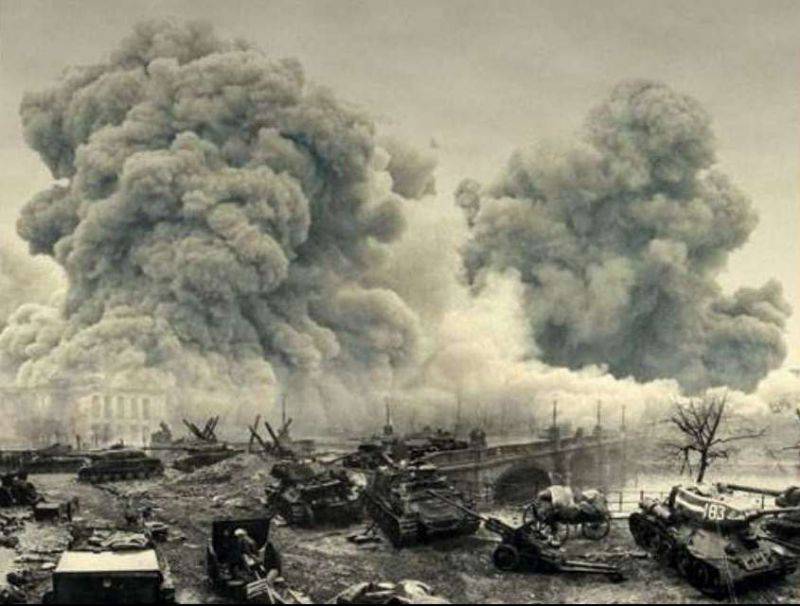
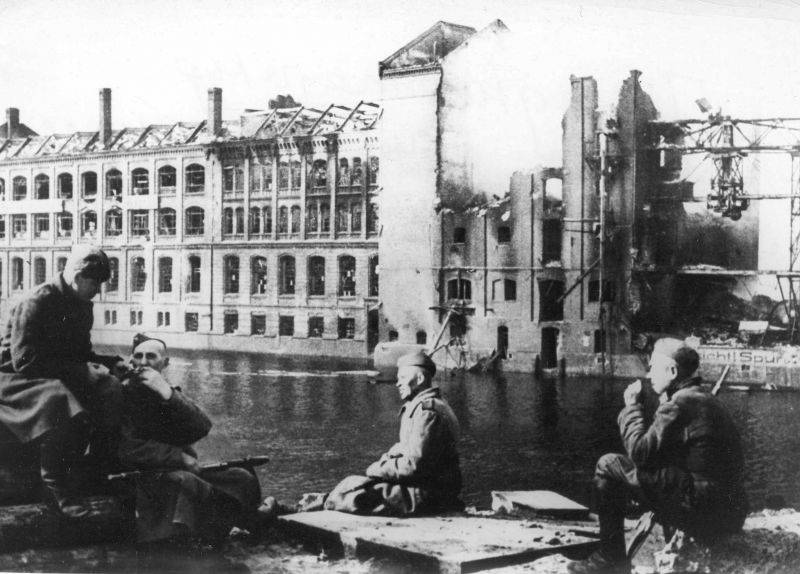
Information